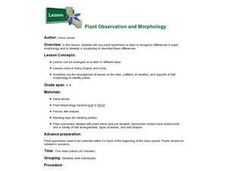Curated OER
Plant Observation and Morphology
Students use plant specimens to explore how to recognize differences in plant morphology and to develop a vocabulary to describe these differences. They brainstorm: What is a plant? What parts do plants have? What is a leaf? Students...
Book Units Teacher
Skill Lessons – Prefixes and Suffixes
Sometimes the best way to understand a concept is to break it down. Young vocabulary pupils work with word parts in a hands-on activity that prompts them to connect flash cards with affixes to their root and base words. Additionally,...
Curated OER
Vocabulary Lesson-Pre-K Through Grade 2 and ESL
Students say the name of pictures of simple objects, people and places, choosing 15 to use for the lesson plan. Students glue pictures in a scrapbook and write the word for each picture beside it. Students complete word recognition...
Curated OER
English Words from Greek and Roman Names of Gods
Hydra/hygiene, Muse/music. Many English words are built on roots derived from the names of Greek and Roman gods. After examining a list of Greek and Roman gods and the meaning of their names, class members find the root in a list of...
Curated OER
Root Words from Greek and Roman Gods' Names
Prepare a stack of index cards with a Greek or Roman god's name on one side and their description on the other. Then, use the worksheet attached to brainstorm as many words that contain the root from each card. Pupils also create their...
Curated OER
Fish Anatomy
Students identify and interpret the internal anatomy of the fish. They also identify and define vocabulary for anatomical parts and anatomical functions and forms. Finally, students identify and interpret the differences in fish...
Curated OER
Introduction To Floral Morphology
Pupils create a model of the four basic whorls of flowers using a water bottle, construction paper and Q-tips. They then examine fresh flower specimens to see how the basic structure can vary in different species of flowering plants.
Cornell University
Fibers, Dyes, and the Environment
Nanofibers can be made through electrospinning or force spinning in order to reduce the negative impact on the environment. Pupils study the role of fibers and dye on the environment through a series of five hands-on activities. Then,...
Curated OER
Island Biogeography and Evolution
Students use this activity as a logic problem that is based on real organisms and real data. The problem is to develop phylogenies for seven related populations of lizards living on the Canary Islands. Three phylogenetic charts are...
Curated OER
Making an Edible Coral Polyp
Students study anatomy. For this coral reef lesson, students recreate the anatomy of a coral polyp using edible materials. They work in pairs following step-by-step instructions given by the teacher. This lesson includes a list of...
Virginia Department of Education
Adaptation and Evolution
Um may be the atomic symbol for confusion, but it won't be needed in this instructional activity. Scholars rotate through seven stations completing experiments, hands-on activities, writing exercises, and analysis. Stations include...
Curated OER
Using Amino Acid Sequences to Show Evolutionary Relationships
Compare protein fragments, count amino acids, and use the information to explore common ancestry. The resource mentions a student worksheet, however, a separate printable worksheet is not provided. The exercises are written into the...
Curated OER
Using Amino Acid Sequences to Show Evolutionary Relationships
Junior biologists compare the amino acid sequences from fragments of five different globin molecules. They count the letter differences between each species pair. They construct a graphic representation of the evolutionary relationships...
Curated OER
See Turtles Nest! See Turtles Hatch!
Students graph data of sea turtles hatching rates from Watamu/Malindi Marine National Park and Reserve in Kenya. In this math lesson, students use real life science data to calculate mean and median values. Students use the data to...
Curated OER
Island Biogeography and Evolution: Solving a Phylogenetic Puzzle With Molecular Genetics
Students engage in solving a logic problem based on real organisms and real data. They develop phylogenies for seven related populations of lizards living on the Canary Islands.
Curated OER
Limu in Your Lunch
Students explore various types of algae found in Hawaii. In this science lesson, students research species of the three types of limu and identify various uses. Students explore products that contain limu.
Curated OER
Do you see what I see?
Students examine the importance of making and recording observations and accurately describing an object. In this biology lesson students work in groups and report to the class what they learned.
Curated OER
Coral Reef Ecology
Students explore coral life cycles. In this coral ecosystems lesson plan, students view videos explaining the life cycle of coral, including examples of sexual and asexual reproduction. Students read a related article cooperatively in...
Curated OER
Macroinvertebrate Sampling
Young scholars identify macroinvertebrate species to investigate ecological systems and the relationship between humans and the environment.
Curated OER
Studying Species by Examining the Evolution of the Canidae Family
Students examine the definition of species. Students complete a phylogentic tree of the Canidae family. They write an essay justifying why or why not wolves and dogs should be classified as different species.
Curated OER
Natural Selection: Exploring the 'Ohi'a Common Garden
Seventh graders examine natural variation by visiting the Ohi'a Common Garden in Volcano, Hawaii. In this natural selection lesson, 7th graders study background information about phenotypes, genotypes, and phenotypic plasticity before...






















